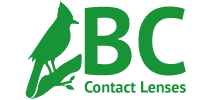So your first ever supply of contact lenses has arrived and it’s time to double check that you received exactly what you ordered. You look at the lens box and realize some things seem to be written in code. Not to worry, we are here to decipher the cryptic symbols and make it easy to understand. Pictured below is an example of a typical contact lens box. Here’s what the numbers, abbreviations and terms actually mean.

AXIS: If you have a prescription correcting for astigmatism you will always have an “axis.” This is the rotational angle of the curve of your eye and is measured in degrees. In the picture above, the axis is 180 degrees.
BC or Base Curve: Every contact lens has a “base curve”. The number indicates the steepness or flatness of the contact lens. Today most contact lenses come in two base curve options. If you have a steep cornea you need a smaller base curve. If you have a flat cornea you need a larger base curve. This is usually determined by your eye care professional by measuring curvature of your cornea by using a keratometer. In the picture above, the base curve is 8.5.
CYL or Cylinder: Contact lenses designed to correct for astigmatism will always have a minus symbol in front of the cylinder number. Contact lenses made to correct for astigmatism are sometimes called “toric.” In the picture above, the cylinder is -0.75.
DIA or Diameter: Every contact lens has a diameter. The diameter determines how much the lens will cover your cornea. Most contact lenses today come in just one diameter. In the picture above, the diameter is 14.5.
Expiry Date: Indicates that the lenses in the box should not be used beyond the date of expiration or risk causing serious damage to your eyes. In the picture above, the expiry date is written in Month/Year format and is December 2017.
PWR or Power: Is also known as the “sphere” power and can have a plus (+) or minus (-) symbol in front of it. The plus symbol indicates correction for people that have difficulty seeing up close, otherwise known as farsightedness or hyperopia. The minus symbol indicates correction for people that have difficulty seeing far away, otherwise known as myopia or nearsightedness. In the picture above, the power is -3.25.
